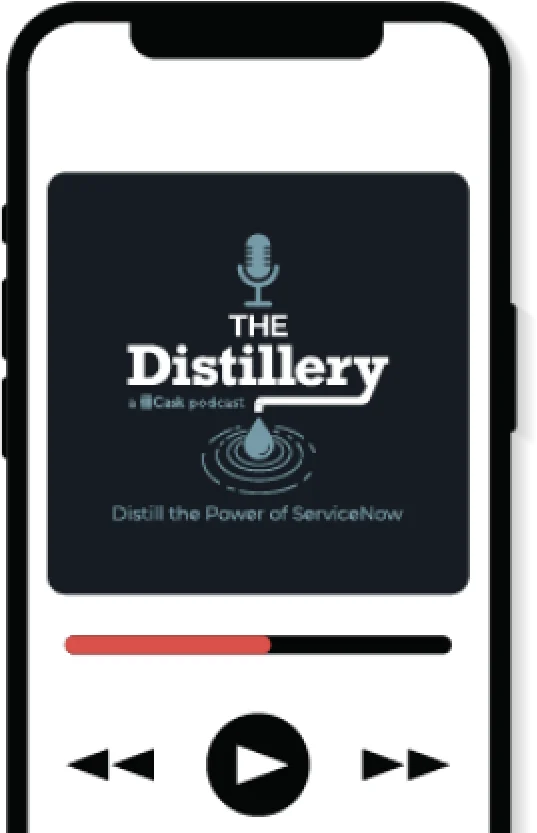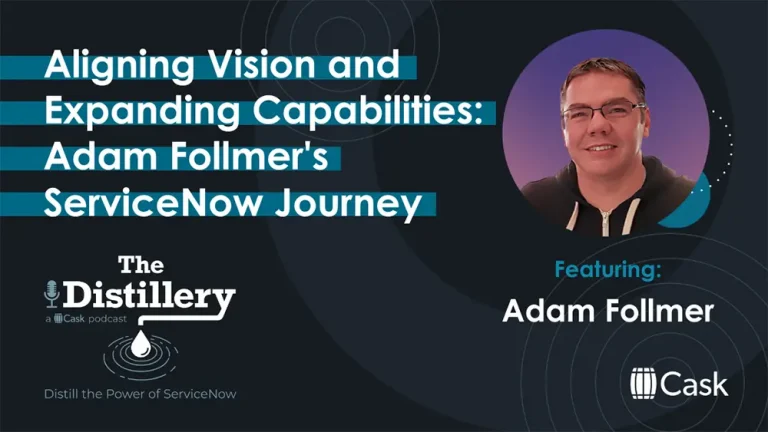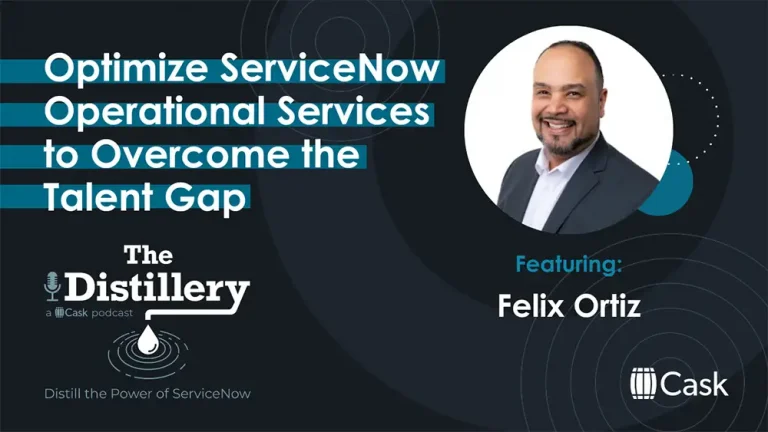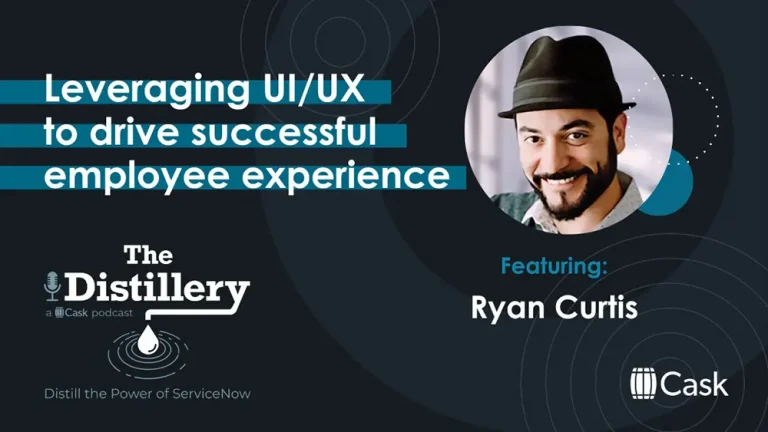Your Host:
Sean Dawson
Our Guest:
Michelle Headrick
Join Michelle Headrick and Sean Dawson as they explore how generative AI is transforming application development on the ServiceNow platform. In this episode, Michelle shares how AI is enhancing rapid development, accelerating prototyping, and improving outcomes. They also discuss how AI invites more people into development and debunk the myth of the robot overload. Tune in to learn how generative AI can elevate your ServiceNow app dev while you also avoid common pitfalls.
Sean Dawson: Hello, and welcome to another episode of the Cask Distillery Podcast, where we unlock the full potential of ServiceNow with expert insights and practical strategies. You’re only going to get this here on the Cask Distillery Podcast. And I’ve got another, just, amazing guest with me today: Michelle Headrick, who is in charge of our app development division. We’re going to be talking to her about generative AI on, you know, with low-code capabilities in ServiceNow and what that looks like.
But before I get into that, I wanted to give a little intro into Michelle and her background. She is a multiyear, multiteam program manager and has been doing this for many, many years. She’s been in the application space for over 20 years, dealing with business intelligence and data warehousing and learning. Really, she’s been involved in some of the most impactful applications here at Cask in federal, state, and local and commercial spaces.
I want to give you a warm welcome, Michelle, to the podcast. Thanks for coming on and taking time out of your schedule.
Michelle Headrick: Oh, thanks, Sean. It’s so great to be here. I’ve loved watching all these podcasts. They’re super fun, watching everybody in their different take on all the amazing things coming out.
Sean Dawson: Yeah. It’s honestly a privilege to be able to be here with all the great people that have come on, including yourself, and talking about these things and bringing value to our clients and our potential clients and listeners of the podcast.
So, with that, let’s get into this. So, this is a hot subject right now, is generative AI. And I know—I think most people know—open AI as far as, you know, ChatGPT and all that stuff. But it’s a new thing coming into ServiceNow. So what I wanted to do, for those that aren’t familiar, from your viewpoint, talk about, first of all, what is generative AI, and what does that look like right now?
Michelle Headrick: Yeah. So, hopefully, many people have been in, playing around with ChatGPT and some of the other tools. Yeah, generative AI is just what it sounds like. So, it’s artificial intelligence that actually generates content. And in some cases, that content is documents or, you know, an agenda for a meeting. I use it for that every once in a while, but it could also be code and workflows.
And so that’s what’s really exciting is it’s a tool to really help take us to the next level. I remember being in college before Google was really a thing, so, and I know that puts a—dates me a little bit, but it’s pretty cool to see how people are embracing generative AI and some of the impacts that we see already.
Sean Dawson: Yeah. I remember on our pre-call, we were talking about Ask Jeeves, if anybody remembers that. It ages both of us. It’s before Google. I think about my kids: Honestly, they don’t have a clue. Yeah. So, with that in mind, how are you seeing generative AI within ServiceNow in the ecosystem now?
Michelle Headrick: Yeah. So, you know, you see it all the way across the platform and all the different workflows. We kind of focus in the application build on the creator workflow side, but it’s definitely hitting the IT workflows in terms of, like, the agent and helping the agent with their day to day. And then also in HR. So I think we’ll see it everywhere. But on the creator side, it really helps us build things. It helps us build things faster, right? So, one of the things that really leaning into is text to code and then text to workflow, which is pretty exciting for us, because I think one of the things we also talked about is how do we use it?
So we’re not really replacing our developers, right? But we’re helping them do their job better and augmenting them. And it’s really about getting tools into our users’ hands faster so we can get that fast feedback loop going.
Sean Dawson: Yeah, and you kind of answered this within that, is how—one of my next questions was how is generative AI going to impact low-code development? And it just helps get results faster, essentially. But is there anything else beyond that you’ve seen that is benefiting low-code development?
Michelle Headrick: Yeah, for sure. So our developers have been using chat GPT quite a bit, like, since it came out, right? We all, we’re all, like, in there using it, I think, quite a bit. But what they find is the code that it generates doesn’t necessarily fit like ServiceNow best practices. It doesn’t necessarily use the right syntax for what we need. And so having it embedded in the platform is going to be huge, because we know that the code that it gives us is going to fit best practices, and it is going to use the right syntax.
So, that’s super exciting. I think some of the other things that we see are really like the whole workflow, like, being able to visualize that sooner and faster is huge because, again—and we had this conversation earlier—but when we’re building things, inevitably, we can talk through a user story. We can, like, diagram a flowout perfectly.
And then when we get folks in there, they’re like, “Oh, that wasn’t what I really wanted.” So, being able to generate that stuff faster is going to be huge. So, yeah, those are some of the things that we’re pretty excited about.
Sean Dawson: Yeah. Yeah. And we talked about that, like, getting a proof of concept. Getting that end-to-end view quicker, because normally, we go through workshops and stories and demo or—sorry, dev sprint, then demo, and then it’s, like, well, we didn’t realize that’s “Wow!” It was gonna look like, but it was—that’s the way we described it. That’s the way we workflowed it out. So, do you—and you might not know, but I was curious—do you have a percentage that you could say? Like, in general, we think we’re saving about this much amount of time that’s getting results faster. Is there a time there that you’ve been seeing?
Michelle Headrick: Yeah, that’s really tough. I think, generally, we like to have something in our customers’ hands about two weeks in, I think. Maybe not in the first couple of releases, but where we’re seeing ServiceNow go, I really think that we’re gonna be able to generate some sort of proof of concept in the conversation, like, immediately.
So, we’re talking about moving from that very first kind of iteration, those two weeks up to, like, we’re having more functional people build those things up front. We see that a little bit with, like, citizen development, right? The new low-code tools that ServiceNow has produced. If we can have somebody functionally in the first kind of workshop building it right then, yeah—so that time is two weeks sooner. And I think we’ll just see that go faster and faster as we build.
Sean Dawson: Yep. And so we’ve talked about end-to-end in proof of concept. And I know that this will impact users. But I was curious what your thoughts on how can this impact the end-user experience or the customers going into ServiceNow? Not necessarily the admins, but what are your thoughts on that? Like, what is it going to do? And how is this going to benefit users?
Michelle Headrick: Yeah, I think the sky’s the limit. It’s almost hard to just imagine all the things. I think it’ll impact everything. From, you know, getting the users into a knowledge base article or videos to help them when they’re kind of stumbling through a process on the other side of the keyboard to actually embedding AI into the workflow.
So, starting to generate things for the users as they’re asking for them. I think that’s going to be really cool to see. And we’ll see it in the next few releases of ServiceNow, which is really neat—that they can, you know, kind of embed some of that generative development, especially around knowledge-based circles, really quickly.
I think it’s going to be all about getting them help faster and then making a more intuitive user experience. So, from their perspective, in some cases, they might not even know that AI is doing things like directing them into the right places. So, yeah, that’s going to be—it’s going to be really great for the user experience.
Sean Dawson: Yeah. Well, I think an AI search for the user, you know what I mean? If it’s on and enabled and it’s mature, they get their answers quicker. So, I see it totally helping out there. And it’s so new, a lot of people don’t realize what that really means. I mean, they see the announcement at Knowledge; they see the news articles and NVIDIA and ServiceNow. “What does all of it mean? What does it really mean to me?” So that’s where the question came from. So, that’s great.
Have you seen any—I had a note about any data around productivity gains, and I guess it’s more around the dev. But the way I’m seeing it right now is you’re looking at, like, a framework, and generative AI is really an assistant. So you still have to have the skill set to get into it to tell it what to do. But have you seen anything around productivity gains when, even in citizen development, that you’ve seen so far?
Michelle Headrick: Yeah, it’s—and it’s not just per productivity, but almost like it’s enabling us to be more collaborative, right? So, different skill sets, able to get in and do things. Whereas before, we needed a pro code developer to do X, Y, Z. Yeah, we’re going to speed their work up a great amount, and that’s great for them. They’re going to have access to code snippets and everything else that they need faster.
But really, it becomes more of a collaboration with less technical people that aren’t maybe necessarily pro code, but they know the business, right? They really understand the business well. And so we used to have kind of a business analyst that sat in between those two folks and helped to translate. I think more and more, you’re going to see business analysts and people in the business being able to build their own applications and then go to the pro code side when they need to augment that even further and push the limits a little bit. Yeah.
Sean Dawson: That makes sense. Cause I remember I did citizen development, not within ServiceNow, but it was another platform. And I remember going to, like, things like forums, stack overflow, you know, grabbing stuff, but it would always be a little bit broke, like, not just so you might be able to tweak it, but you might not be able to. So it makes sense.
Yeah. So we’ve talked about—so far, we’ve talked about advantages, but there’s—to me, there’s a fear—an element of fear with AI. And we’ve talked a little bit about it even in this conversation. But, you know, with all the advantages, do you see any disadvantages to generative AI within ServiceNow?
Michelle Headrick: Yeah, I think it’s going to be the same kind of disadvantages that we saw when things like access databases and Excel spreadsheets sheets became, just, accessible to everybody, right? When things are accessible to everybody, you have to be careful about governance. You have to think about “How do I make sure that my data is accessible to the right people, that we’re not violating any kind of, you know, things in terms of security” and protecting your business.
So I think that you have to be careful about those types of things. And then, also, just app sprawl, making sure that you know what’s happening where in the business and that you’re not just generating 5 million one-offs and that you still have that single pane-of-glass view to your business, I think, are huge.
Sean Dawson: Okay. Yeah.
Michelle Headrick: Oh, like, it’s easy to build the wrong workflow, right? So, it’s easy for somebody that, you know, if you just have a myopic view and you’re building it and putting that out into the world, well, you got to make sure that you’re being super collaborative and that you understand exactly all of the things that you need to build in.
Sean Dawson: Yeah. We actually have some episodes that are surrounding that a little bit about how to eliminate painting yourself into a corner with custom apps and when to do it. So yeah, we’ve been on that thought, and we’ve been trying to give the listeners that view of development, and you mentioned governance, too. It’s thinking the big-picture “What are we doing?” “Why are we doing it?” type thing.
In your eyes, what I wanted to ask you what your thoughts are. What’s next? What can customers look forward to with generative AI in your eyes? And then, where/what do you see us going with it?
Michelle Headrick: Yeah. I mean, I think in the next few releases, what’s really exciting is the ease of deployment across, like, using AI to help us to actually get into more of a DevOps kind of mindset. So, easing those deployments, I think, is, like, now. It’s going to happen with App Engine Management Center and some of the other things that are coming out with App Engine.
And again, I think it’s the embedding of really starting to see AI in with those low-code tools, at least from the creator workflow side. So, again, making it more accessible to everybody and just speeding up the process of building things. Yeah. That’s happening now, so, really exciting.
Sean Dawson: That’s good. So, I mean, that’s my list of questions for you. Is there anything I missed or anything you’d like to add to the conversation? Anything you’re seeing, anything you’re experiencing, anything you’d like to share?
Michelle Headrick: Yeah. I think it’s, you know, interesting talking to our developers about this, right? Because I think there’s this kind of fear about AI coming to take our jobs. You know? And that’s legit. Our jobs are going to change, right? But I do think—earlier this year, I had kind of a health scare. I was diagnosed with cancer. And so, during the course of that, my husband works in data and analytics in healthcare, and kind of getting to know how they’re using AI to augment healthcare has been fascinating.
I think we’re going to see the same thing on the application development side. And what I know is, like, I still want my doctor on the other end of that, right? I still want somebody that understands what my care needs to look like, who I am as a human being, why those things are important. And I think we’ll see the same thing where AI is not going to replace us. It’s going to augment us. It’s going to make us faster, make us better at our jobs. And it’s gonna, you know, it’s really going to transform the way we do things. But I think it’ll be for the better, ultimately.
And I do understand the sci-fi scary “The machines are coming for us.” You know? And I don’t discount that there’s some very legitimate fears around AI. But I think, for the most part, this is really exciting. And it’s really gonna be cool to see what happens. I don’t think we can really know right now. So yeah.
Sean Dawson: Well great. Thanks for that insight. And thanks again, Michelle, for taking time out of your schedule. And I wanted to take a second for our listeners is also to ask a favor. Could you do us a favor and like and share our content? And also, we’d love to hear from you as well. We’d love to hear about things that you want to see from Cask and The Distillery Podcast and other ideas and things that we can bring to you as value.
So let us know. Like and share. And thanks a lot for joining us for this episode of The Distillery.
We’re with you for what comes next
You're working in a rapidly shifting environment.
Global dynamics, AI advancements, heavy competition–the only certainty is change.
We get it. And we’re here to help you harness the full potential of ServiceNow to simplify transformation.
Let's navigate the future together.



Recent Episodes
We’re with you for what comes next
You're working in a rapidly shifting environment.
Global dynamics, AI advancements, heavy competition–the only certainty is change.
We get it. And we’re here to help you harness the full potential of ServiceNow to simplify transformation.
Let's navigate the future together.



Let’s Innovate Together!
Request a Complimentary Consultation from Cask.
Cask’s unparalleled expertise is ready to tackle your unique challenges and transform your aspirations into reality. We’ll listen to understand your requirements and offer a tailor-made approach that aligns with your strategic objectives.
Your journey to innovation is just a click away. Schedule your meeting with our Cask advisors and become part of the success story that defines your organization’s future.



Sign up for our Distillery Podcast
Stay up to date with the latest episodes














